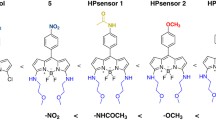Abstract
Bovine serum albumin was chosen as a model protein to study the effect of the functionalization of the ε-NH2 of lysine residues with different carbon chains on the physical properties of proteins. Thus, BSA has been acylated and sulfonylated by means of anhydrides and sulfonyl chlorides, respectively. The secondary structures of modified BSA, studied by far-UV CD, showed very slight changes except after sulfamidation. However, near-UV CD and intrinsic fluorescence spectra revealed important conformational perturbations for proteins bearing long carbon chains. Furthermore, the binding of an apolar probe (ANS) to BSA revealed an improvement of surface hydrophobicity after modification. Meanwhile, Scatchard plot results indicate that only 20% of the hexanoyl carbon chains lie at the surface of the proteins. Solvent conditions should influence the exposure of these chains and consequently the surface hydrophobicity of proteins.
Similar content being viewed by others
Author information
Authors and Affiliations
Rights and permissions
About this article
Cite this article
Gerbanowski, A., Rabiller, C., Larré, C. et al. Grafting of Aliphatic and Aromatic Probes on Bovine Serum Albumin: Influence on Its Structural and Physicochemical Characteristics. J Protein Chem 18, 325–336 (1999). https://doi.org/10.1023/A:1021043529923
Published:
Issue Date:
DOI: https://doi.org/10.1023/A:1021043529923




